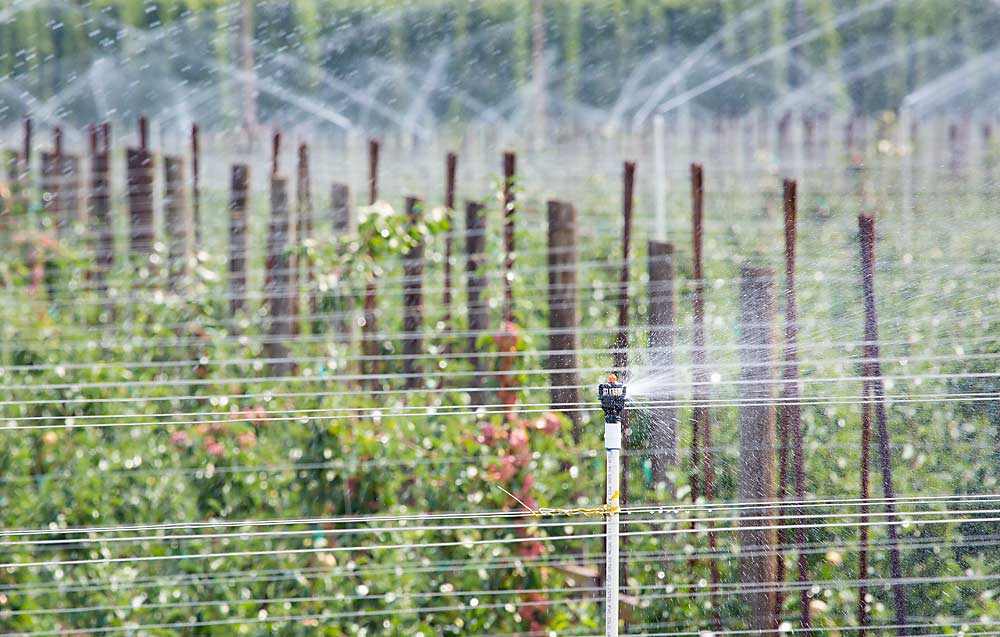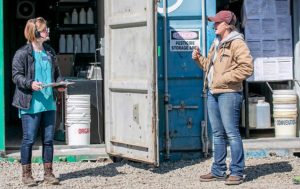
Evaporative cooling remains a critical tool for orchardists trying to prevent heat stress to sensitive fruits, but a proposed rule to regulate water quality and food safety on farms could complicate matters for those who rely on it.
This month, the U.S. Food and Drug Administration is taking public comment on the proposed rule — a long-awaited part of the Food Safety Modernization Act’s Produce Safety Rule, which was otherwise finalized in 2015. Initially, regulators proposed growers regularly test irrigation water for pathogens that pose human health risks, such as E. coli, but they went back to the drawing board in response to public comment.
The new proposal replaces that testing requirement with a “preharvest agricultural water assessment” that growers would need to conduct annually to assess their risk of applying potentially pathogen-harboring water to produce in the days before harvest, according to the FDA. The assessment would take into account a variety of factors, including: how the water is used; the crop; environmental conditions, such as frequency of rain and ultraviolet light exposure; how protected the water distribution system is from potential contamination; and nearby land uses related to animal activity and manure application. If the assessment turns up “reasonably foreseeable hazards,” growers would then have to adopt mitigation strategies.
“While most growers didn’t like the added burden of testing water, this leaves them more vulnerable because it’s very subjective,” said Faith Critzer, an associate professor of food safety and technology at the University of Georgia, though she previously worked on food safety research for Washington State University. “If I was in a grower’s shoes, I wouldn’t have a good idea what the risks are.”
The FDA plans to provide a tool to help growers assess their agricultural water quality risks, but the agency has not yet released details for review by stakeholders. That makes it hard to know how implementation of the proposed rule will play out, she said.
“The risk from adjacent land use is really tough because: a) they don’t own the land; b) they don’t know what’s going on from day to day; and c) define ‘nearby,’” Critzer said. “In some outbreak cases, they’ve cited things that are quite far away.”
Connie Fisk, director of produce safety for the Washington State Department of Agriculture, said the state regulatory agency is also awaiting the FDA’s definition of “nearby.” While inspecting ag water systems isn’t new, the ag water assessment would ask individual growers for many more specifics.
“This goes beyond just an inspection of the water system to now include systems-based considerations of all animal activity, soil amendment use, et cetera on adjacent and nearby lands and how they may introduce hazards into the ag water,” she said. “I agree that awareness of these hazards is important to fully understanding the risk associated with applying agricultural water to produce, but assessing and controlling contamination on adjacent or nearby land is likely out of the grower’s control.”
When the rule is finalized, Fisk said her team will develop education and outreach programing to help growers comply, similar to how they conducted “practice test” inspections as the rest of the FSMA rules went into effect.
The FDA had set a compliance date for the new preharvest agricultural water requirements in January of 2022. A new date has yet to be announced, but Fisk said that until then, the WSDA is exercising enforcement discretion.
Assessing risk assessment
Compared to the one-size-fits-all water testing approach the FDA previously proposed, the risk assessment approach could be beneficial to some growers, such as those with late-harvesting apples, because they would be unlikely to apply overhead cooling within days of harvest, said Kate Tynan, the senior vice president of the Northwest Horticultural Council. But for cherries, early apples and anything else that needs a spray application or cooling in the days leading up to harvest, if growers identify a potential risk to water quality, it could become a significant burden.
And all growers will face a new recordkeeping requirement, she added, but, after a learning curve, that shouldn’t change much from year to year.
If reasonably foreseeable hazards are identified, growers will have to adopt mitigation measures. This is where tree fruits may have more options than other commodities that are more at-risk, such as leafy greens, under this proposed rule, Tynan said.
The best mitigation that may be available to orchardists is allowing for a pathogen die-off period of four days between water application and harvest. But that won’t work if growers need to apply cooling water or spray protective coatings to safeguard fruit, Critzer said.
For all produce growers, if the risk stems from animal activity, manure or human wastewater on nearby lands, under the proposed rule, the mitigation must be implemented immediately.
Another mitigation approach available to pome fruit may be to show (with documented research) that the storage period or controlled-atmosphere conditions reduce pathogen survival.
“These things die off at pretty fast rates when we hold them in storage,” Critzer said.
Another mitigation strategy would be to implement regular water testing, though it’s no longer required. Testing doesn’t allow growers to skip the risk assessment, but the results could be part of the puzzle growers piece together to make risk management decisions, said Fisk.
Commercial washing could be another option, though data would be needed to demonstrate what it does in terms of pathogen die-off, Tynan said.
“The NHC hopes — and what we will be advocating for in comments — is that the burden in these cases should largely remain one of documenting how current practices already adequately mitigate risks associated with agricultural water, and not require the adoption of costly new practices like water treatment or extensive yearly water testing on every water source,” Tynan said. “That is the best-case scenario, and we believe the science is on our side under a risk-based approach.”
In addition to NHC’s comments on behalf of the industry, Tynan and Critzer both encouraged growers to submit their comments to the FDA.
While the agency is still likely to amend the proposal somewhat after public comment, the framework of the approach is likely to remain, Tynan said.
“At the end of the day, it’s a lot of unknowns,” Critzer said. “I think the most important thing is for growers to comment on it.”
—by Kate Prengaman







Leave A Comment